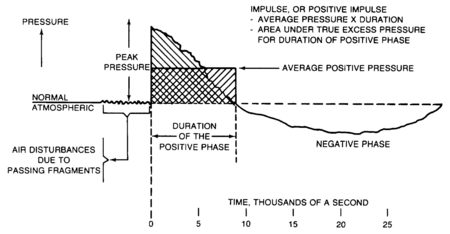Blast (explosives)
Blast is the process by which explosives, in a millisecond or less, are converted to hot explosive gases. Depending on the construction of the container holding the explosive, as much as half the force may go into disrupting it rather than producing effects; the strongest cases are military warheads and gravity bombs.
Blast effects are most complex in air, although they are not trivial in air or in solids. Indeed, there is a complex discipline of forming solid structures with explosive waves, perhaps most complex in the compression systems of nuclear weapons.
Air
At the leading edge of the detonation is a sharply delineated reagion called the shock front, in which the pressure rises dramatically. Its initial velocity is much greater than sound but drops dramatically. The gases of detonation follow it.[1]
Water
Solid
References
- ↑ Military Explosives, U.S. Department of the Army, September 1984, TM 9-1300-214, p. 4-11 to 4-13
